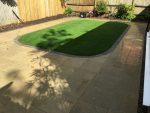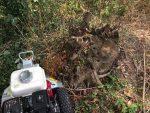When it comes to hedge maintenance, regular hedge cutting / trimming is the single most important thing to do. Regular hedge trim will make your hedge compact and thick right from the bottom.
Why plant a hedge?
Hedge can be a perfect garden boundary, but the wrong one may give you troubles.
- hedges provide shelter.
- They dumpen noises, reduce strong winds
- The obvious they give you privacy.
- security but not all hedges. Thorny, prickly varieties like for example:
Common holly
Firethorn
Blackthorn
Barberry
Buckthorn
- some hedging plants like photinia give you a beautiful seasonal change.
- hedge supports wildlife. Birds love nesting in them as well as eating some berries.
- unlike wooden fences, hedges won’t need replacing for many many years and they don’t require anything more than regular hedge cutting.
I can’t stress that too much.
Hedges need your commitment to regular hedge cutting / trimming.
All types of hedging need at least one hedge cut a year. Some varieties more than one.
A regular light prune is much better for you and your hedge then an occasional heavy cut.
Power tools do a quick job if done regularly. High and overgrown hedges often need costly specialist equipment or professional help
to get them back into shape.
You can avoid a lot of problems in future if you choose the right hedging plants for your boundary.
Hedge planting – the right choice.
The many benefits of growing hedges on your boundary depend on selecting the right plants for the situation. If you choose an unsuitable variety you could be faced with a range of problems, especially if the hedge grows too big. It will be difficult to trim and may cut out light to your garden or house.
- Its roots could deprive other plants of water and nutrients, and even interfere with paths and buildings.
- Oversize hedges will intrude on your garden space, and may cause problems with neighbours.
- Oversize hedges can be costly and time consuming to cut back and most conifers, including Leyland and Lawson’s cypress, will not tolerate hard pruning.
- If the hedge borders a road or path the local authority could get involved, and insist the hedge is cut back.
Luckily there is a wide range of plants available so it’s not difficult to achieve an attractive healthy hedge – one which will take only as much upkeep as you can manage, and create an attractive feature in your neighbourhood, not a bone of contention.
| Growth rate | hedge cutting – how often | Size if unpruned | Foliage | Prickly? | |
|---|---|---|---|---|---|
| Beech | xxx | Once | Large tree | D/LL | No |
| Berberis | xx | Once | Large shrub | E | Yes |
| Cherry laurel | xx | Once | Large shrub | E | No |
| Cotoneaster | xx | Once | Large shrub | E | No |
| Escallonia | xx | Twice | Large shrub | E | No |
| Firethorn | xx | Twice | Large shrub | E | Yes |
| Hawthorn | xxx | Twice | Small tree | D | Yes |
| Hazel | xxx | Once | Small tree | D | No |
| Holly | x | Once | Small tree | E | Yes |
| Hornbeam | xx | Once | Large tree | D/LL | No |
| Lawsons cypress | xx | Twice | Large tree | E Conifer | No |
| Leyland cypress | xxx | Twice | Large tree | E Conifer | No |
| Portugal laurel | x | Once | Large shrub | E | No |
| Privet | xx | Three | Large shrub | E | No |
| Rose | xx | Once | Large shrub | D | Yes |
| Western red cedar | xx | Twice | Large tree | E Conifer | No |
| Yew | x | Once | Large tree | E Conifer | No |
Key:
Growth rate, for established plants
xxx – over 60cm/year
xx – 30-60cm/year
x – 15-30cm/year
Foliage:
D – deciduous
LL – dead leaves held in winter
E – evergreen
My favourite hedging plant has to be YEW ( taxus )
Classic choice but everlasting and makes an excellent hedge. Doesnt need that much hedge cutting either.

Tidy Gardens can trim/prune most of hedges, but if you are that lucky and have spectacular yew like on a picture above then DON’T call us. Call for a crane ! 🙂






My hedge is nearly 6-feet tall and 3-feet wide. I would like to reduce the size to 4-feet tall and 2-feet wide. How can I do this without damaging it? Thank you.
What type of hedge ?